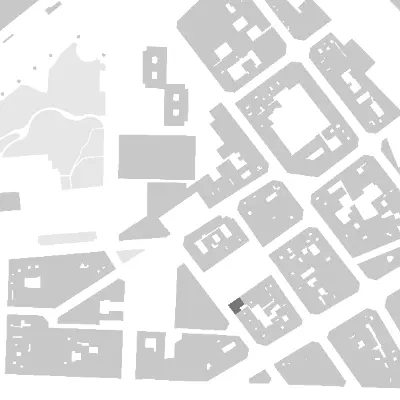Herenni

下载所需积分: 5
建筑工作室gr-os,由RIBA注册建筑师胡安·古雷亚·鲁梅领导,最近在西班牙巴塞罗那完成了一栋六单元公寓楼,合作方为GAR Arquitectura的乔安娜·阿尔赫里奇。
该建筑位于一个半步行广场,称为Plaza Herenni,或大多数邻居称之为Plaza del Sol。这个广场在19世纪失去了原名,当时Hostafrancs村与巴塞罗那市合并,但在当地的集体记忆中依然保持完整。
该地点位于西南角,介于食品市场和工业西班牙公园 "曾是重要的纺织厂" 之间,是旧工业社区转型的象征性见证。
对该地区丰富历史的浓厚兴趣,以及对档案的查阅和与当地居民的对话,极大地促进了项目的概念发展。
一位邻居回忆起市场美丽的釉面陶瓷屋顶是如何被石棉这种有毒材料所取代的,而石棉在巴塞罗那的城市景观中仍然有着强烈的存在,尤其是在我们发现的地点。
这两种材料的可塑性结合在一起,创造了新建筑的外立面,采用釉面陶瓷板,重现了石棉板的波动形态。新立面成为一个吸收环境并与之互动的元素,随着光线、颜色和周围纹理的变化而改变其色调。
花岗岩基座框架了入口,并帮助建筑与其直接环境相结合,地面铺设了相同的材料。
从一开始,入口大厅和公共楼梯就被赋予了重要性,借鉴了巴塞罗那著名城市规划“Eixample”的宏伟大堂。第一段楼梯的轻微倾斜重现了20世纪初建筑中的一种手势,同时为垂直服务留出了空间。楼梯以雕塑的方式展开,顶部的大天窗在一天中产生不同的自然光场景。公共区域宽敞,与住宅内部的材料共享,减少了公共与私密之间的障碍。在屋顶上,一个大型公共露台旨在鼓励邻里之间的社交互动。
公寓的内部布局在一个网格内组织,生成灵活的空间,允许根据不同的需求和生活形式进行调整。通过在一个角落开设一个大天井,所有房间都能享受到阳光和交叉通风。服务设施和假天花板占据了网格的两个轴线,复合楼板在卧室和客厅中暴露,最大化了层高,创造了工业风格的格子天花板。
通风立面提供了高水平的热绝缘。此外,机械空气更新系统和空气源热泵 "ASHP" 降低了能耗,提高了公寓的舒适度。
Architecture studio gr-os, led by RIBA chartered architect Juan Gurrea Rumeu, has recently completed a six-unit apartment building in Barcelona, Spain, in collaboration with Joana Argerich of GAR Arquitectura.
The building is located in a semi-pedestrian square known as Plaza Herenni, or Plaza del Sol for most of the neighbours. The square lost its original name in the XIX century, when the village of Hostafrancs was merged with the city of Barcelona, though it has remained intact in the collective memory of the place.
The site occupies the south-west corner, halfway between the food market and the Park of Industrial Spain (formerly an important textile factory) and is a symbolic witness to the transformation of an old industrial neighbourhood.
A strong interest in the rich history of the district, followed by archive consultations and conversations with locals, contributed significantly to the conceptual development of the project.
A neighbour recalled how the beautiful glazed ceramic roof tiles of the market had been replaced by asbestos, a toxic material which still has a strong presence in the urban landscape of Barcelona, and specifically in our site as we found it.
The plasticity of both materials was combined to create the façade of the new building, made of glazed ceramic panels that reproduce the undulation of asbestos sheets. The new facade becomes an element that absorbs the context and interacts with it, changing its tone depending on the light, colours, and textures of the surroundings.
A granite plinth frames the access and helps ground the building in its direct context, paved with the same material.
From the beginning, great importance was given to the entrance hall and the public staircase, looking at the grand lobbies of the “Eixample”, Barcelona’s famous urban plan. The slight inclination of the first flight of steps reproduces a gesture repeated in early 20th century buildings and, at the same time, makes room for the vertical services. The staircase is developed in a sculptural manner and a large skylight at the top generates different scenes of natural light throughout the day. The communal areas are spacious and share materiality with the interior of the dwellings, reducing the barrier between public and private. On the rooftop, a large communal terrace is intended to encourage social interaction between neighbours.
The internal layout of the apartments is organised within a grid, generating flexible spaces which allow for the programme to be adapted to different needs and forms of living. By opening a large patio on one of the corners, all rooms benefit from sunlight and cross ventilation. Services and false ceilings occupy two axes of the grid, and the composite slab is exposed in bedrooms and living rooms, maximising floor to ceiling height and creating an industrial coffered ceiling.
The ventilated façade provides a high level of thermal insulation. In addition, a mechanical air renewal system and ASHP reduce energy consumption and increase comfort in the apartments.